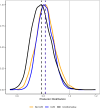Leveraging a Bayesian Approach in a Comparative Effectiveness Trial of Major Adverse Cardiovascular Events
- PMID: 41246528
- PMCID: PMC12614493
- DOI: 10.2147/CLEP.S540048
Leveraging a Bayesian Approach in a Comparative Effectiveness Trial of Major Adverse Cardiovascular Events
Abstract
Purpose: We applied a Bayesian approach to further investigate the association of sodium-glucose cotransporter-2 inhibitors (SGLT2i) with the composite outcome of Major Adverse Cardiovascular Event and Heart Failure hospitalization (MACE+HF) and its individual components leveraging the ability of a Bayesian approach to incorporate prior clinical information and to make probability statements about the parameters.
Methods: We use a Bayesian time-to-event model, where the covariates are directly modeled in the hazard function. Following propensity score matching, we fit three Bayesian models; one with a relatively flat, normal prior on the SGLT2i coefficient (Uninformative) and 2 with informative priors from a meta-analysis (based on a cohort with no history of cardiovascular disease [No CVD] and cohorts with a history of CVD [CVD]). We estimate the posterior distribution for the hazard ratio (HR) using a Hamiltonian Monte Carlo algorithm. It allows us to estimate the probability of a meaningful protective association (HR < 0.90) in addition to point and interval estimates.
Results: The posterior means and 95% credible intervals for the HR suggested a protective association for SGLT2i versus dipeptidyl peptidase 4 inhibitors (DPP4i) for the MACE+HF outcome: No CVD: 0.82 (0.68, 0.96), CVD: 0.82 (0.71, 0.94), and Uninformative: 0.79 (0.65, 0.94). The probability of a meaningful protective association for the No CVD, CVD, and Uninformative priors were 88%, 92%, and 93%, respectively. The probability of a meaningful protective association for the HF hospitalization, CVD hospitalization and CVD death components of MACE+HF were 95%, 67%, and 93%, respectively.
Conclusion: The Bayesian analysis allowed for the incorporation of prior information via an informative prior and further investigation of the association between SGLT2 and the components of the MACE+HF composite outcome. It allowed for the calculation of an easily interpretable summary measure, the probability of a meaningful protective association.
Keywords: bayesian inference; cardiovascular disease; diabetes mellitus; hamiltonian monte carlo; propensity score methods; time-to-event analysis.
© 2025 Lwin et al.
Conflict of interest statement
Dr Amber Hackstadt and Mr. Cole Beck report grants from PCORI, outside the submitted work. Dr Amber Hackstadt reports support grants from Bristol Myers Squibb Foundation, outside the submitted work. The authors report no other conflicts of interest in this work.
Figures




References
-
- Joseph JJ, Deedwania P, Acharya T, et al. American Heart Association Diabetes Committee of the Council on Lifestyle and Cardiometabolic Health; Council on Arteriosclerosis, Thrombosis and Vascular Biology; Council on Clinical Cardiology; and Council on Hypertension. Comprehensive management of cardiovascular risk factors for adults with type 2 diabetes: a scientific statement from the American Heart Association. Circulation. 2022;145:e722–e759. doi: 10.1161/CIR.0000000000001040 - DOI - PubMed
-
- Richardson TL Jr, Halvorson AE, Hackstadt AJ, et al. Primary occurrence of cardiovascular events after adding sodium-glucose cotransporter-2 inhibitors or glucagon-like peptide-1 receptor agonists compared with dipeptidyl peptidase-4 inhibitors: a cohort study in veterans with diabetes. Ann Intern Med. 2023;176:751–760. doi: 10.7326/m22-2751 - DOI - PMC - PubMed
LinkOut - more resources
Full Text Sources
Research Materials
Miscellaneous

